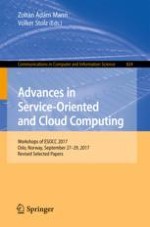This volume contains the technical papers presented in the workshops, which took place at the 6th European Conference on Service-Oriented and Cloud Computing, ESOCC 2017, held in Oslo, Norway, September 2017: First International Workshop on Business Process Management in the Cloud, BPM@Cloud 2017; Third International Workshop on Cloud Adoption and Migration, CloudWays 2017.
The 9 full papers were carefully reviewed and selected from 12 submissions. In addition, the volume also contains 8 EU Projects papers, describing projects presented at the European Projects Forum, which took place at ESOCC 2017. The papers focus on specific topics in service-oriented and cloud computing domains such as limits and/or advantages of existing cloud solutions, future internet technologies, efficient and adaptive deployment and management of service-based applications across multiple clouds, novel cloud service migration practices and solutions, digitization of enterprises in the cloud computing era, federated cloud networking services.
